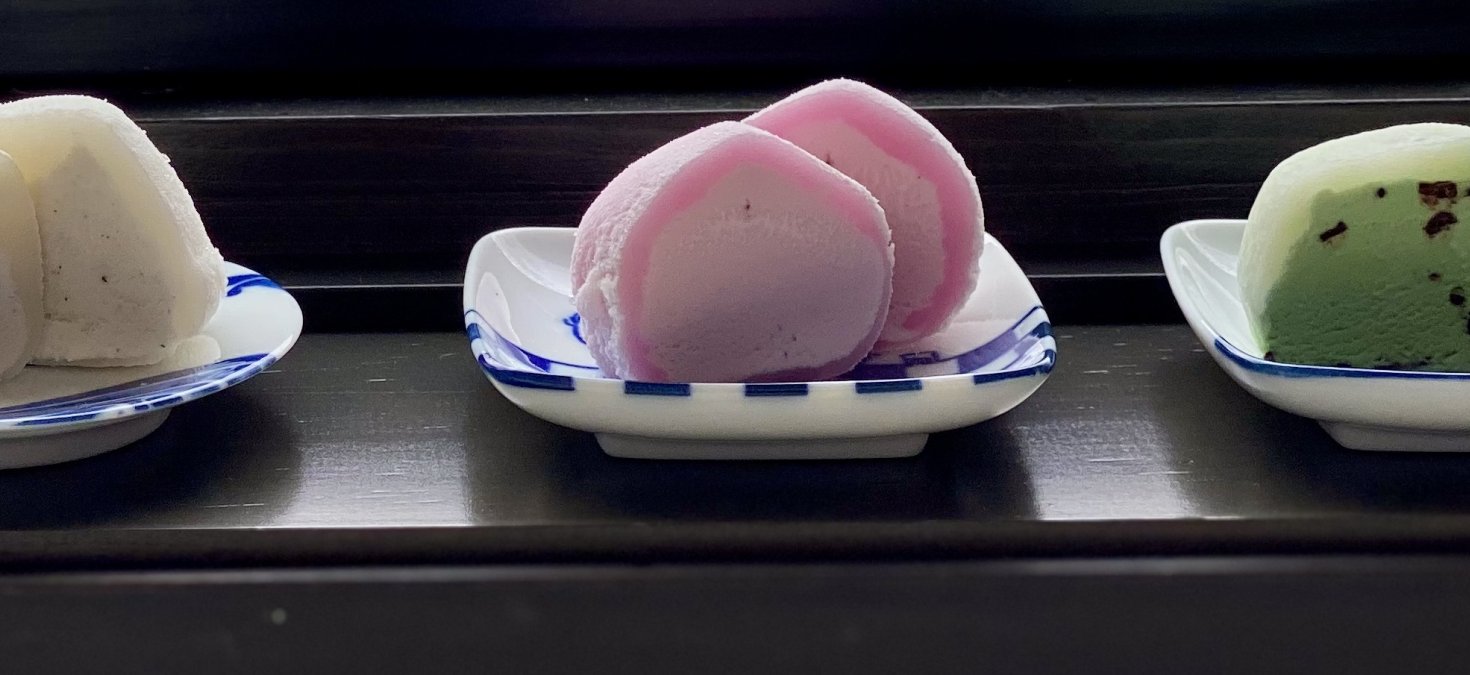Mochi Ice Cream

By Trevor Graham, UIUC Junior in East Asian Languages and Culture
For many of us, we cannot think about Japanese sweets without thinking about mochi. And in America, we can’t talk much about mochi without thinking about mochi ice cream!
Mochi is a Japanese cake/sweet made from pounding glutinous rice into a sticky paste and molding it into shape. Mochi can then be prepared in many ways, mochi ice cream being one of the most recently implemented ideas. Most popularly, the mochi includes a sweet filling inside such as anko (red bean paste) to make a Japanese confectionary (wagashi) called “daifuku.” Mochi is a part of Japanese tradition during the New Year, where there is a traditional ceremony called “Mochitsuki” in which people use a traditional mortar (usu 臼) to hold the sticky rice and alternate using a giant wooden mallet (kine 杵) to pound the rice into mochi. During the New Year, a certain kind of mochi called Kagami Mochi is also made as a traditional decoration placed in household Shinto altars. Kagami mochi consists of two round mochi cakes stacked atop one another, which has been said to symbolize various things including the coming and going years, yin and yang, and the moon and sun. Regardless, mochi is indeed not just a sweet but a traditional food relevant to Japanese culture.
Despite mochi’s long history, the invention of mochi ice cream is attributed to around 1981 when a Korean Company, Lotte, began selling the sweet as a special type of “snow viewing daifuku.” The idea behind this original mochi ice cream was to enjoy as a special kind of daifuku to eat while enjoying the pastime of “yukimi” or “snow viewing.” The filling inside the mochi being ice cream was said to enhance the experience of appreciating the snow’s beauty despite its often bitterly cold accompanying weather — what is cold can also be wonderful. At this point, however, the sweet was not really known as “mochi ice cream.” In the early 1990s, the Los Angeles-based bakery Mikawaya became the first to start selling mochi ice cream in the United States as a “US/Japan fusion food” around the early 1990s. The family-run bakery came up with the idea after the wife, of Japanese descent, visited Japan on a trip and tried daifuku for the first time. The couple had already been using rice flour to make mochi-based baking products, but after seeing the mochi filled with sweet bean paste in Japan, they wanted to try filling the mochi cakes with something else that the American audience would adore, and decided on ice cream. The bakery produced three original kinds of mochi ice cream: green tea, red bean, and mango flavors. Today, the bakery is credited as selling the original mochi ice cream and has expanded to sell the sweet under the Mikawaya company name in the worldwide market. The sweet is sold today in a multitude of flavors today, including green tea, strawberry, chocolate, vanilla, mango, coffee, banana, and even cookies and cream. Moving away from the traditional importance of mochi, the company treats mochi ice cream today as a way to bring people together socially and enjoy a little moment of happiness with each other. With how delicious mochi ice cream is, one can see why people would be sharing in happiness while sharing mochi ice cream with each other!
Mochi ice cream thus has origins in Japanese tradition because of the traditional value of mochi. However, mochi ice cream is truly a result of the crossroads of both American and Japanese food culture. Even in the local Urbana-Champaign community, there are many options to buy mochi ice cream! At the local Harvest Market, there is a whole “mochi bar” with individually wrapped mochi ice cream cakes of all kinds of flavors. They also have many very Americanized flavors of mochi ice cream from the same company available there, like “ice cream sundae” and “s’mores” flavors! Visiting the mochi bar with friends or family would be a great way to try all kinds of mochi ice cream in the local area, and would especially be a great way to cool off in the summer! Additionally, local Asian food markets such as Green Onion sell mochi ice cream from other brands, including Maeda-En and Miyawaka, and even Harvest Market has multiple brands of mochi ice cream. It is apparent that mochi ice cream has become quite popular across even local Illinois food markets.
Nowadays, mochi ice cream can even be made at home with the correct ingredients that can be bought at Japanese food market, or even online. Most importantly, you will need mochiko, or sweet rice flour (the rice that is pounded into mochi). Furthermore, in making mochi ice cream at home, one can use the ice cream flavor of their choice. At home, more exciting combinations of ice cream and mochi are waiting to be made!